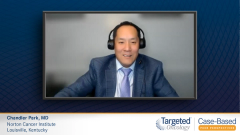
Adjuvant Pembrolizumab in Patients with Clear-cell Renal Cell Carcinoma
An overview of the KEYNOTE-564 study design followed by an analysis of 30-month follow-up data presented at the 2022 ASCO Genitourinary Cancers Symposium.
Chandler Park, MD: So what I want to do, is just a real quick overview of the study, and then get to the 30 month follow-up. In the phase 3 KEYNOTE-564 study of adjuvant pembrolizumab, the study design was key allogeneic criteria of histological confirmed clear cell renal cell. Patient has had to have a nephrectomy 12 weeks or less prior to randomization, no prior systemic therapy, ECOG performance of 0 or 1, and patients were also evaluated with a tissue sample for PD-L assessment. Now, the patients were randomized to two arms. One arm was pembrolizumab at 200 mg every three weeks for a total of one year. The second arm was placebo for three weeks for a total of one year. The primary endpoint was disease-free survival. The key secondary endpoint was overall survival; other secondary endpoints include safety. Now in terms of the updated data at ASCO; what we looked at is - they presented a really nice hazard ratio with a Kaplan-Meier curve. And what they found was that the KEYNOTE-564 disease for survival at the median 30.1 month follow-up, there was a clear separation of the curve with a hazard ratio of 0.63, which is a 37% reduction. Now the other thing they found was they separated the groups, as I mentioned, into three separate groups. You had the intermediate risk, the high risk, and the M1 NED. And so in terms of the updated 30 month follow-up, in the intermediate group, there was a separation of the Kaplan-Meier curve with a hazard ratio of 0.68. Now in our patient, the high risk, there was actually a stronger signal of a hazard ratio of 0.6. And also, the other group that I mentioned, which is the M1 NED, the hazard ratio was 0.28. And so, those were the things that were discussed at the ASCO with the updated 30 month follow-up.
No new signals for us that have been using immunotherapies in our practice, and so, certain things like the most common side effect adverse events was fatigue where up to 20.3% of the patients had fatigue, pruritus, and up to 18%, hypothyroidism 17%, diarrhea 15%, rash 15%; arthralgias joint pain at 10%. Now one thing that they presented, which is very interesting for our practice in oncology is, what is the median time to these adverse events, for instance, fatigue. Typically, fatigue on average occurred around six weeks in terms of initiation of pembrolizumab. In terms of pruritus, it was around - close to the second or third treatment, which is around 8.3 weeks. Hypothyroidism, it was around 12 weeks or around cycle four. Diarrhea occurred around eight-to-nine months, and rash, interestingly, the average was around 10 weeks. Those are the common adverse events that occurred in this study.
Transcript Edited for Clarity








































